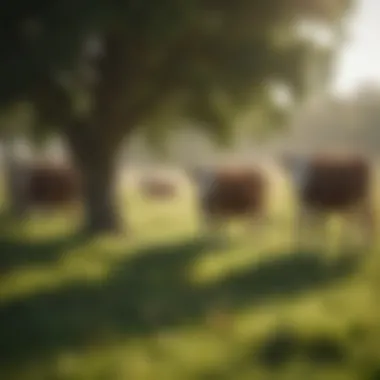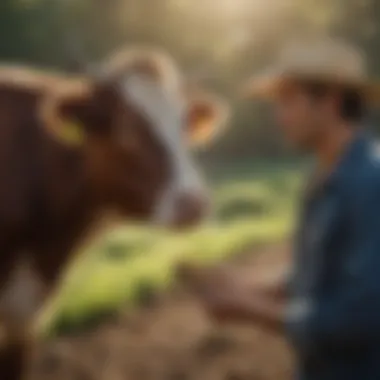Strategies to Reduce Cow Methane for Sustainable Farming


Intro
Methane emissions from cattle have become a hot topic in discussions about climate change and sustainable farming practices. The role cows play in contributing to these emissions cannot be overstated; they're like the elephant in the room of agriculture. As we dive into strategies for reducing methane generation from cows, it's critical to grasp some foundational concepts and terminology.
Key Concepts and Terminology
Definition of Terms
Understanding the key terms related to methane emissions is essential for addressing this complex issue effectively. Here are a few that often come up in discussions:
- Methane (CH₄): A potent greenhouse gas with a much higher global warming potential than carbon dioxide over a shorter time frame.
- Enteric Fermentation: This is the digestive process that cattle undergo, where they produce methane during digestion, particularly when breaking down fibrous food.
- Aspirin Burden: Refers to the total amount of methane emitted by each cow over its lifetime.
- Sustainable Agriculture: Practices aimed at meeting current food needs without compromising future generations' ability to produce food.
Overview of Relevant Practices
When we talk about reducing methane emissions from cattle, several practices emerge. These aren't just band-aids but strategies designed to tackle the underlying issues:
- Dietary Modifications: Focusing on the cow's feed can be a game changer. Adding seaweed into their diet can drastically cut methane production.
- Genetic Selection: Breeding cattle that naturally emit less methane could lead to a more sustainable herd in the long run.
- Manure Management: Proper manure handling can significantly reduce emissions that arise from manure storage and application.
Current Trends and Innovations
Latest Research and Developments
Recent studies have shed light on surprising methods to reduce cattle methane emissions. For instance, research by scientists has identified specific nutritional supplements that can minimize methane during digestion. It's fascinating to note how something as simple as altering feed composition can have profound effects on greenhouse gas emissions.
Emerging Technologies and Tools
Emerging technologies are also playing a pivotal role in addressing this challenge. Tools like methane sensors connected to farm management systems allow farmers to monitor emissions more precisely. These real-time data can help in making informed decisions that lower overall methane output.
Practical Applications
Step-by-Step Guide
Implementing methane-reduction strategies requires more than just awareness; it calls for action. Here’s a simplified guide on how farmers can start:
- Assess Current Feeding Practices: Review the cattle's diet to identify possible changes.
- Introduce Supplements Gradually: Consider nutritional enhancements like seaweed or specific oils known to cut down on methane.
- Explore Genetic Options: Investigate breeding programs that focus on low-methane emissions.
- Enhance Manure Management: Optimize storage techniques and explore anaerobic digestion options for manure handling.
Troubleshooting Common Issues
Implementing these strategies may pose challenges. Some common issues include resistance to changing feeding practices or the upfront costs of new technologies. It is essential that farmers remain patient and persistent, as the long-term benefits often outweigh initial hurdles.
"By tackling methane emissions through innovative practices, we are not only improving cattle health but also driving sustainability in agriculture, ultimately contributing to a healthier planet."
Understanding Methane Emissions from Cattle
Methane emissions from cattle represent a significant environmental challenge that directly impacts climate change. The cattle sector is a prominent contributor to greenhouse gases, especially in agricultural economies. Recognizing the sources and mechanisms of these emissions is crucial in mitigating their effects. Understanding how methane is produced, the factors that influence its emissions, and the implications for sustainable agriculture can pave the way for innovative practices and farm management improvements.
The Science of Methane Production
Methane is a potent greenhouse gas, with a global warming potential many times greater than carbon dioxide over a short term. It is primarily produced during digestion in ruminants like cows through a process known as enteric fermentation. When cattle consume feeds, they undergo complex digestive processes that convert food into energy. Methanogenic microbes present in their stomachs play a crucial role in breaking down food, which inevitably results in the production of methane gas. During digestion, this gas is expelled, mostly through belching.
Understanding this science helps in identifying specific strategies aimed at reducing methane production, as there are potential innovations in dietary management or feed additives that can alter digestive processes and minimize emissions.
Factors Influencing Methane Emissions
Several key factors influence the amount of methane emitted from cattle. Three notable aspects to consider are animal nutrition, digestive processes, and environmental conditions.


Animal Nutrition
The nutrition of cattle is a critical component in determining methane emissions. This involves not just what they eat but also the ratio and quality of those feeds. High-quality forages—like alfalfa or clover—are often considered beneficial as they can optimize digestion and minimize methane production. Conversely, low-quality feeds rich in cell wall components may lead to higher emissions as they take longer to ferment, producing more methane in the process.
A focus on high-nutritional feeds can lead cattle to produce less gas, which is a huge advantage. A notable feature of enhanced animal nutrition is the potential to use dietary supplements such as oils or even seaweed, which have shown promise in reducing methane emissions. However, the cost and availability of these feeds can pose challenges for farmers.
Digestive Processes
When looking at digestive processes, it’s essential to understand the unique functions of a cow's rumen. The rumen houses microorganisms that help in breaking down tough plant fibers, which in turn produces methane as a byproduct. The characteristics of these digestive processes can dictate how much methane is produced.
By changing feed formulations to include more easily digestible ingredients or supplements that suppress methanogens, it's possible to reduce emissions. Yet, while these strategies show promise, one must balance digestibility with overall cattle health and productivity to ensure they don’t compromise nutrient intake.
Environmental Conditions
The environment in which cattle are raised also plays a role in methane emissions. Factors such as temperature, humidity, and substrate availability can all affect the efficiency of digestion in cattle. For instance, extreme heat can stress animals and impair their feed intake, which could lead to inefficient fermentation processes that could raise methane output compared to optimal conditions.
Moreover, managing grazing land and manure in diverse weather situations is another key point. Implementing effective manure management techniques such as composting or anaerobic digestion can enhance environmental conditions, thereby helping to lower overall methane emissions. However, farmers need to consider the feasibility of such systems on their farms and the investment required.
"Understanding the multifaceted nature of methane emissions is key in navigating agricultural sustainability."
By addressing these factors holistically, the agriculture industry can move towards more sustainable practices, ensuring a balance between productivity and environmental responsibility.
The Role of Cattle in Agricultural Emissions
The role of cattle in agricultural emissions is a pressing issue, particularly as nations grapple with agricultural sustainability and climate change. Cattle contribute significantly to greenhouse gas emissions; this isn’t just an agricultural concern but a global one that affects every living being. Understanding how these emissions occur and the specific contributions of cattle is essential for developing effective mitigation strategies.
Global Contributions to Greenhouse Gases
Globally, livestock, especially cattle, are responsible for a considerable portion of agricultural greenhouse gas emissions. The Food and Agriculture Organization (FAO) has indicated that livestock farming accounts for about 14.5% of all human-induced emissions. Cattle emissions predominantly come from methane—a potent greenhouse gas with a global warming potential many times stronger than carbon dioxide over a short period.
Here are some notable aspects regarding cattle’s contributions:
- Maine Emission Source: Enteric fermentation in cows is the main source, resulting from the digestive process where microbes break down food in the stomach. This produces methane, which is then expelled by belching.
- Manure Management: The way manure is stored and treated also adds to the methane emissions. When manure is left in open pits or lagoons, it decomposes anaerobically, releasing significant amounts of methane.
- Land Use Changes: Expanding cattle farming often leads to deforestation and land degradation, further exacerbating climate issues by releasing stored carbon in trees and soil.
"Every piece of meat we consume impacts the planet. Understanding the indirect effects helps us choose a more sustainable path forward."
Cattle vs. Other Livestock
When comparing cattle with other livestock, the story becomes more nuanced. While all livestock contribute to greenhouse gas emissions, cattle tend to be the heaviest offenders.
- Emission Comparison:
- Nutritional Contribution: Livestock provide crucial nutrients; beef and dairy are significant sources of protein, calcium, and other vitamins. However, the environmental costs need weighing against their nutritional value.
- Global Trade Implications: The demand for cattle products has surged internationally, and to meet this demand, many regions are intensifying cattle production. This trend raises concerns about sustainable practices, land use, and how future emissions can be controlled.
- Cattle produce more methane per unit of protein than sheep, pigs, or poultry. Cows’ larger size and their unique digestive systems lead to higher per capita emissions.
- Pigs and poultry emit fewer greenhouse gases per kilogram of meat or eggs, which makes them relatively more efficient in terms of their environmental footprint.
In summary, the complex interplay between cattle emissions and agricultural practices requires thoughtful consideration, innovative strategies, and strong policies to mitigate the impact effectively. By addressing both the emissions data and livestock comparison, we can better understand the overall landscape of agricultural emissions to effectively work toward sustainable solutions.
Impact of Methane Emissions on Climate Change
The significance of the impact of methane emissions from cattle on climate change cannot be overstated. Methane, although present in smaller quantities compared to carbon dioxide, is much more effective at trapping heat in the atmosphere. This greenhouse gas has a global warming potential that is over twenty-five times greater than that of carbon dioxide over a hundred-year period. Consequently, understanding the nuances of how and why cattle contribute to methane emissions plays a crucial role in climate change discussions.
Moreover, the agricultural sector, particularly livestock farming, stands at the crossroads of sustainability and production efficiency. The insights gained from this aspect can open doors to effective strategies that not only address environmental concerns but also promote operational viability for farmers. It's a cycle worth understanding—reducing methane emissions can lead to a more sustainable agricultural future.
Short-Term vs. Long-Term Effects
When talking about the effects of methane emissions, it’s vital to distinguish between the short-term and long-term impacts.
Short-term effects are primarily linked to the immediate increase in atmospheric temperatures. As methane can remain in the atmosphere for about a decade before it oxidizes into carbon dioxide, the rapid climate change associated with spikes in methane levels creates severe weather events and shifts in local climates. This can lead to agricultural challenges, such as unpredictable rainfall and extreme temperatures that further jeopardize crop yields.


Meanwhile, the long-term effects paint a broader picture. Over time, methane emissions contribute to a sustained increase in global temperatures. This escalating temperature affects not just agriculture, pushing crops and livestock beyond their adaptive capacities, but also influences the resilience of ecosystems. In this scenario, the accumulated effects may lead to disrupted natural cycles, biodiversity loss, and even altered water patterns, which are critical for both agricultural productivity and environmental health.
Ecosystem Consequences
The ecological implications of cow methane emissions extend beyond temperature impacts. We must consider how these emissions affect various ecosystems.
- Soil Quality: Methane emissions impact soil health indirectly. Warmer temperatures can lead to altered microbial activity in soil, which may change nutrient cycling and negatively affect plant growth.
- Water Resources: Changes in precipitation patterns linked to climate change can lead to both flooding and drought, straining the agricultural sector reliant on stable water sources.
- Wildlife Displacement: Ecosystems in which livestock agriculture is prevalent may experience habitat degradation, which pushes wildlife further afield, threatening biodiversity.
"Cattle farming has its footprint on the environment — the challenge lies in balancing this need against ecological stewardship."
As farmers and agricultural enthusiasts, understanding these consequences is imperative. With increased awareness, stakeholders can take meaningful steps to mitigate methane emissions, ensuring not only their operations thrive but also that ecological balance is restored.
Strategies for Cow Methane Reduction
Methane emissions from cattle represent a significant concern within sustainable agricultural practices. Finding effective strategies for their reduction is pivotal, not only for lowering greenhouse gas emissions but also for promoting healthier ecosystems and enhancing farm profitability. By exploring various avenues, such as dietary modifications and advanced breeding practices, the agricultural community can take meaningful steps towards mitigating the impact methane has on our climate and environment.
Dietary Modifications
High-Quality Forages
High-quality forages play a crucial role in managing methane emissions from cattle. They are typically richer in nutrients and digestibility compared to poorer quality forages. This characteristic allows cows to ferment these feed sources more efficiently, leading to increased energy absorption and, ideally, reduced methane production during digestion. Switching to high-quality forages can result in better milk and meat yields while simultaneously cutting down the methane produced during the digestive process. However, the adoption of high-quality forages might require a greater upfront investment in crop management but can pay dividends in the long run by improving overall herd health and productivity.
Seaweed and Other Additives
Seaweed and other feed additives are emerging as popular choices to combat methane emissions. Studies have indicated that incorporating seaweed into cattle diets can significantly reduce methane production, primarily due to its unique compounds like bromoform. This additive acts as an inhibitor for methane-producing microbes in the stomach known as methanogens. The implementation of seaweed in cattle feeding regimes, while promising, does come with challenges such as availability and cost in certain regions, which can limit its widespread adoption among farmers.
Breeding Practices
Genetic Selection for Lower Emission Traits
Genetic selection for traits associated with lower methane emissions is an increasingly attractive strategy for cattle producers. By choosing breeding stock that inherently produces less methane, farmers can create entire herds that contribute less to greenhouse gas emissions over time. This approach focuses on identifying and selecting cattle with specific genetic traits linked to lower emissions. While promising, the practicality of this strategy can vary widely across different environments and breeding programs.
Advanced Breeding Technologies
Advanced breeding technologies, such as genomics and assisted reproductive technologies, play a crucial role in enhancing breeding programs tailored for lower methane emissions. These techniques enable farmers to identify superior genetic traits more quickly and accurately than traditional methods. Employing such technology can accelerate the development of cow breeds that not only produce less methane but also exhibit improved productivity and health. Nonetheless, access to these advanced technologies can be an issue, especially for smaller farms lacking the resources available to larger operations.
Manure Management Techniques
Anaerobic Digestion
Anaerobic digestion is another strategy that’s gaining traction in methane reduction efforts. Through this process, organic matter from manure is broken down by microorganisms in an oxygen-free environment, producing biogas that can be captured and used as an energy source. This technique not only mitigates methane emissions but also turns waste into valuable energy, providing a dual benefit to farmers. However, the initial setup and ongoing operational costs can be significant, making it more suitable for larger operations.
Composting Methods
Composting methods offer a more traditional approach to manure management. By decomposing manure through aerobic conditions, composting can help reduce methane emissions associated with traditional manure handling practices. The advantage of composting lies in its potential to produce nutrient-rich organic matter that can enrich soil health. However, the efficiency of this method can depend on factors such as the carbon-to-nitrogen ratio and moisture levels in the compost pile, which require careful management.
By adopting a range of innovative and research-backed practices, the agricultural sector can make significant strides in reducing its methane footprint while ensuring viable agricultural futures.
Technological Innovations in Methane Reduction
The advancements in technology are reshaping the agricultural landscape, particularly when it comes to reducing methane emissions from cattle. These innovations not only promise to lessen the carbon footprint of livestock production but also aim to improve the overall efficiency and sustainability of agriculture. Implementing such technologies can lead to better resource management, economic benefits for farmers, and a significant decrease in the detrimental effects of methane on climate change.
Monitoring and Measurement Tools
Before addressing methane reduction, it's essential to understand the source and level of emissions. This is where monitoring and measurement tools come into play. Technologies such as remote sensing, direct measurements, and modeling software are crucial in gauging methane output from cattle.


- Remote Sensing: Utilizing satellites and drones equipped with sensors can offer a birds-eye view of cattle emissions. These tools collect valuable data over large areas, helping identify trends and problem spots.
- Direct Measurement: Devices like respiration chambers or portable analyzers allow for precise measurement of methane during the digestion process. This hands-on approach yields accurate results and provides insights for researchers and farmers alike.
- Modeling Software: Advanced computer programs simulate various scenarios of cattle feeding and environmental conditions. These simulations help predict how certain practices impact methane emissions.
Implementing these tools effectively sheds light on how emissions fluctuate due to changes in diet, breeding, and environmental factors. This information is critical as farmers can then make informed decisions based on concrete data rather than best guesses.
Emerging Solutions and Products
Innovative solutions and products are steadily entering the market, aimed at minimizing methane emissions while ensuring cattle health. These developments can be categorized into dietary supplements, feed additives, and technology-based solutions.
- Dietary Supplements: Additives like red seaweed, which contains compounds that inhibit methane production during digestion, have gained attention as a promising solution. Studies suggest that including such additives in cattle diets can cut methane emissions significantly.
- Feed Additives: Products such as nitrates and tannins influence the microbial composition in the rumen, potentially resulting in a reduction of methane output. These substances alter fermentation processes, diverting energy from methane production to more useful components.
- Technology-Based Solutions: Wearable sensors for cattle monitor health and methane output. This data can help farmers to adjust herd management practices that alleviate emissions while also optimizing cattle well-being.
"By leveraging these emerging technologies and products, farmers can align with sustainability goals while maintaining productivity."
Policy Implications and Industry Strategies
In tackling the problems posed by methane emissions from cattle, much more than just farm-level practices are necessary. The influence of policy implications and industry strategies cannot be overlooked. This area requires a nuanced understanding of how regulations can shape practices on the ground, as well as how corporate commitments to sustainability can pave the way for meaningful changes in farming. By examining these two aspects, it's easier to see how collaborative efforts across various stakeholders can lead to a reduction in methane emissions alongside fostering a sustainable agricultural system.
Regulatory Frameworks for Emission Reductions
Effective regulations are crucial for initiating and maintaining progress in reducing methane emissions from cattle. Governments around the world are developing frameworks that set measurable emission reduction targets, creating accountability mechanisms for farmers and corporations alike. These frameworks often resonate through a series of policies and incentives, which can be grouped into several key components:
- Emission Standards: Establishing specific limits on the amount of methane that can be emitted by cattle farms. This encourages farm owners to adopt efficient practices or technologies that can help them meet these standards.
- Subsidies and Incentives for Best Practices: Financial backing for farmers who implement low-emission technologies or innovative cattle feeding strategies. This helps to offset the initial costs associated with adopting such practices.
- Collaboration with Research Institutions: Policymakers can partner with agricultural universities and research groups to support studies that focus on effective methane reduction strategies. This collaboration fosters an environment where science meets practical application.
- Public Awareness Campaigns: Information sharing can play an important role in ensuring that the agricultural community understands the significance of methane emissions and the steps needed to combat them.
"A robust regulatory framework serves as the backbone of any effective strategy to reduce greenhouse gas emissions, including methane. It's about aligning interests of farmers with environmental goals."
The role of regulation isn’t just punitive but can also drive innovation, pushing farmers toward smarter practices that are more eco-friendly.
Corporate Sustainability Initiatives
On the other end of the spectrum, corporations in the agricultural sector are increasingly realizing the importance of sustainability—not merely as a nicety but as a necessity. Corporate sustainability initiatives play a pivotal role in the diaspora of methane reduction strategies:
- Targeted Commitments: Many companies are establishing ambitious goals pertaining to greenhouse gases, including methane. By committing to science-based targets, corporations set a benchmark for their emissions, influencing the supply chain along the way.
- Transparency in Reporting: Companies are more frequently providing detailed reports on their emissions, which promotes accountability not just to their shareholders but also to the public.
- Investments in Innovation: There’s a recognition that addressing methane is not only about compliance but also about innovation. Corporate investments in developing new technologies, such as feed additives that inhibit methane production, exemplify this.
- Partnerships with Farmers: Building alliances with farmers to promote best practices and technologies can amplify the corporate impact on methane emissions. Programs that offer training and resources to farmers are instrumental in ensuring that sustainable practices take root at the grassroots level.
The interconnectedness of policy and corporate efforts in addressing methane emissions highlights the necessity of a multi-pronged approach. By understanding these dynamics, agricultural professionals can play a more informed role in the transition to sustainable agricultural practices, further bridging the gap between compliance and genuine ecological stewardship.
Future Outlook for Cow Methane Management
The management of cow methane emissions is not just an immediate concern; it also serves as a critical consideration for the future of sustainable agriculture. As we face ongoing changes in climate and regulatory landscapes, the strategies and practices for reducing methane from cattle must adapt and evolve. Future outlooks in this area can guide farmers, researchers, and policymakers toward more effective implementation of methane-reduction initiatives.
Combining research, innovative farming practices, and community engagement is vital. There are several specific elements that will play a significant role in shaping the future of cow methane management:
- Research advancements: Innovations in livestock genetics and farm technologies present a promising opportunity to tackle methane emissions at their source. Enhanced research into efficient feed types and nutritional strategies can improve digestion, therefore lowering emissions.
- Policy frameworks: Stricter regulations aimed at curbing emissions will likely emerge, compelling farmers to adopt new methods and practices. These could range from financial incentives for lower-emission farming to mandatory reporting on methane outputs.
- Education and training: Knowledge-sharing initiatives for farmers can facilitate the implementation of best practices. Workshops, online courses, and collaborative projects can build capacity and awareness around sustainable practices that effectively reduce methane emissions.
Overall, the future of cow methane management hinges on collaboration across various sectors—research, agriculture, and governance. By aligning these areas, we can develop a comprehensive approach that not only mitigates emissions but also enhances the sustainability of agricultural practices globally.
Research and Development Trends
The importance of research and development in reducing methane from cattle cannot be overstated. Emerging trends in this field are diverse and impactful:
- Genetic Selection: Selective breeding for traits that correlate with lower methane production is gaining popularity. Utilizing genomics, farmers can identify and breed cattle that naturally emit less methane. For instance, studies show that certain breeds, like British Blue and Hereford, have been discovered to emit lower levels than others.
- Innovative Feeds: Research is focusing on dietary additives that can significantly lower methane emissions. For example, including seaweed in feed demonstrates promise, as certain types can reduce methane production by up to 80%.
- Precision Agriculture Tools: Development of monitoring tools, including sensors and software, will equip farmers with data on their herds' methane emissions. With accurate data, necessary adjustments in feeding practices and management can be made in real time.
These advancements underscore the potential for significant methane reductions over time, creating a ripple effect that can influence global agricultural practices.
Community and Global Efforts in Mitigation
Tackling the challenge of methane emissions from cattle is not solely a responsibility of individual farmers or organizations. It requires a collective effort on both local and global scales:
- Collaborative Initiatives: Local farming communities are beginning to form networks to tackle methane reduction together. These networks can share best practices, successes, and failures, creating a collective knowledge base that benefits everyone involved.
- International Partnerships: Global collaborations, like those through the United Nations Framework Convention on Climate Change (UNFCCC), play a crucial role. Countries sharing strategies and insights can foster innovation in methane management.
"Mitigating methane emissions in agriculture depends on a cohesive effort that combines local actions with global frameworks to achieve significant advancements."
- Awareness Campaigns: Engaging the general public through educational campaigns will promote sustainable consumption practices. Encouraging consumers to support lower-emission beef options creates market demand for sustainable products.
In summary, the future of cow methane management is bright, driven by innovative research and robust community engagement. By laying a strong foundation today, we can create a sustainable agricultural landscape for tomorrow.







